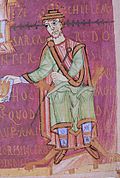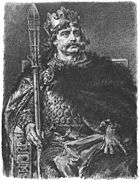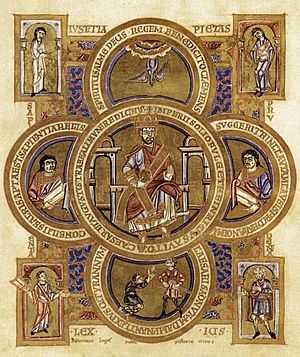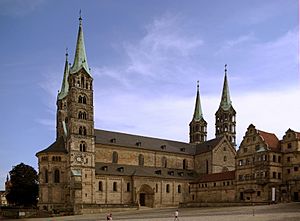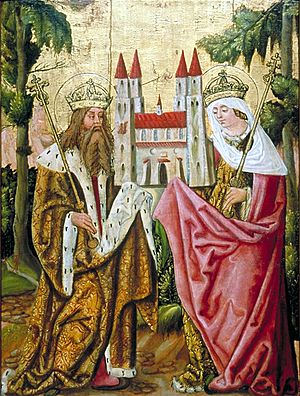Henry II, Holy Roman Emperor facts for kids
Quick facts for kids Henry II |
|
|---|---|
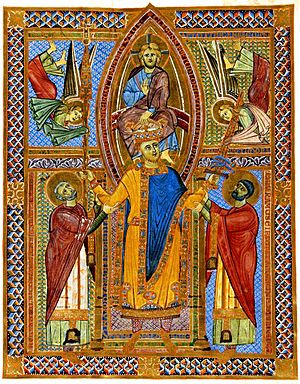
Henry II in a sacramentary c. 1002–1014
|
|
| Holy Roman Emperor | |
| Reign | 14 February 1014 – 13 July 1024 |
| Coronation | 14 February 1014 Old St. Peter's Basilica, Rome |
| Predecessor | Otto III |
| Successor | Conrad II |
| King of Italy | |
| Reign | 15 May 1004 – 13 July 1024 |
| Coronation | 15 May 1004 Pavia, Kingdom of Italy |
| Predecessor | Otto III Arduin of Ivrea |
| Successor | Conrad II |
| King of Germany | |
| Reign | 7 June 1002 – 13 July 1024 |
| Coronation | 7 June 1002 Mainz, Kingdom of Germany |
| Predecessor | Otto III |
| Successor | Conrad II |
| Duke of Bavaria | |
| Reign | 28 August 995 – 21 March 1004 1009 – December 1017 |
| Predecessor | Henry II |
| Successor | Henry V |
| Born | 6 May 973 Abbach, Bavaria, Germany, Holy Roman Empire |
| Died | 13 July 1024 (aged 51) near Göttingen, Germany, Holy Roman Empire |
| Burial | Bamberg Cathedral |
| Spouse | Cunigunde of Luxembourg |
| House | Ottonian |
| Father | Henry II, Duke of Bavaria |
| Mother | Gisela of Burgundy |
| Religion | Chalcedonian Christianity |
Henry II (born 6 May 973 – died 13 July 1024) was a powerful ruler in Europe. He was the Holy Roman Emperor from 1014 until his death in 1024. He was also known as Saint Henry the Exuberant because he was very religious. Henry was the last ruler from the Ottonian dynasty, a family that had ruled Germany and the Holy Roman Empire for a long time.
Henry became the Duke of Bavaria in 995. After his cousin, Emperor Otto III, died suddenly in 1002, Henry became the King of Germany. In 1004, he also became the King of Italy. Finally, in 1014, Pope Benedict VIII crowned him Emperor in Rome.
Henry's father, also named Henry, had rebelled against earlier emperors. Because of this, young Henry spent time away from home. He became very religious early in his life. He was taught by bishops and studied at a cathedral school. When his father died in 995, Henry became the Duke of Bavaria.
Unlike Otto III, who focused on Italy, Henry spent most of his time strengthening his rule in the northern parts of his empire. He had many conflicts with Duke Bolesław I of Poland. Henry also led armies into Italy three times to keep control of the region.
Henry II made his power stronger by working closely with the Catholic Church. He gave many gifts and lands to the Church. He also appointed many church leaders to important government jobs. This helped him balance the power of the nobles. Because he was very religious and supported the Church, Pope Eugene III made him a saint in 1146. He is the only German king from the Middle Ages to become a saint. His wife, Empress Cunigunde, was also very religious and became a saint in 1200. Henry and Cunigunde did not have children. After Henry died, the German nobles chose Conrad II to be the next emperor.
Contents
Early Life and Family
Henry was born in May 973. His father was Duke Henry II of Bavaria, and his mother was Gisela of Burgundy. His family was part of the Ottonian dynasty, a powerful ruling family in Germany.
In 974, Henry's father had a disagreement with Emperor Otto II. Henry's father believed he should rule the Duchy of Swabia, but Otto II wanted to choose his own duke. After two failed rebellions, Otto II removed Henry's father as Duke of Bavaria. He sent him away to live under the care of a bishop. The Emperor also took away some of Bavaria's land to create a new duchy called Duchy of Carinthia.
While his father was away, young Henry lived in Hildesheim. He was taught about Christianity by Bishop Wolfgang of Regensburg. The Emperor wanted Henry to become a church official so he couldn't take part in ruling the empire.
When Emperor Otto II died in 983, Henry's father was set free. He tried to become king himself but failed. In 985, he gave up his claim to the throne. In return, he got his title back as Duke of Bavaria. Young Henry, who was 13, became the ruler of Bavaria under his father. When his father died in 995, the nobles of Bavaria chose Henry to be their new duke.
In 999, Henry married Cunigunde of Luxembourg. Her family had many important connections in western Germany.
Becoming King
The Fight for the Throne
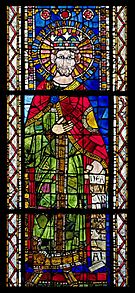
In 1001, Emperor Otto III faced a rebellion in Italy. He asked Henry II to bring more soldiers from Germany. But Otto III died unexpectedly in January 1002. He was only 21 and had no children, so there was no clear person to take his place.
In the Ottonian dynasty, the throne usually went to the Saxon branch of the family. Henry was from the Bavarian branch. Other powerful nobles also wanted to be king.
As Otto III's funeral procession moved through Bavaria, Henry met it. He demanded that Archbishop Heribert of Cologne give him the Imperial Regalia, which were the symbols of royal power, like the Holy Lance. But Heribert had already sent them away. Henry even put the Archbishop in prison to try and get the symbols. But without the regalia or the support of the nobles, Henry couldn't convince them to choose him as king.
So, without the support of many nobles, Henry took a bold step. He had himself crowned King of Germany by Archbishop Willigis in Mainz on 9 July 1002. This was the first time a German king was not crowned in Aachen Cathedral since Emperor Otto I. It was also the first time a king took the throne without being chosen by the nobles. Henry then went to the Saxons and convinced their leader, Bernard I, Duke of Saxony, to support him. In return, Henry promised to respect the Saxons' rights.
Soon after, Henry arranged for his wife, Cunigunde of Luxembourg, to be crowned Queen of Germany in Paderborn on 10 August 1002.
Making His Power Stronger
Henry II spent the next few years making his rule stronger. Herman II, Duke of Swabia, strongly disagreed with Henry's right to be king. Herman believed he was the true heir. They fought battles, but neither side won completely.
Henry traveled through different parts of his kingdom, like Saxony, Bavaria, and Swabia. He wanted to get the support of all his people, not just the nobles who traditionally chose the king. Because Henry was related to the Ottonian dynasty, the nobles eventually accepted him. Herman II finally gave in to Henry's power in October 1002. Henry allowed Herman to remain Duke of Swabia until he died the next year. After that, Henry took control of the Duchy himself.
In 1003, Henry of Schweinfurt, a margrave in Bavaria, rebelled against Henry II. The King had promised to make him the Duke of Bavaria if he supported Henry's claim to the throne. But when Henry became king, he didn't keep his promise. Instead, he supported the Bavarians' right to choose their own duke. Henry I of Luxembourg became the new Duke of Bavaria. The rebellious margrave joined forces with Bolesław I of Poland. But his rebellion was quickly stopped, and he lost his title in 1004. Henry II then created the Diocese of Bamberg in 1007. He gave the Church control over the margrave's old territory to prevent more rebellions.
First Trip to Italy
When Otto III died in 1002, Italy slipped out of German control. Arduin of Ivrea declared himself King of Italy in Pavia. He had the support of many Italian nobles. However, Arduin had been removed from the Church in 997 for killing a bishop. This allowed his enemies in the Church to support Henry II as the rightful ruler of Italy.
In 1004, Henry II led an army into Italy to fight Arduin. He marched through the Brenner Pass to Trento. Many Italian church leaders and nobles swore loyalty to Henry. On 14 May 1004, Archbishop Arnulf II crowned Henry as King of Italy in Pavia. Unlike earlier kings, Henry II wore two crowns: one for Germany and one for Italy.
After the coronation, a fight broke out between some local people and Henry's soldiers. The city caught fire, and many people died.
Henry then returned to Germany without going to Rome to be crowned Emperor. This was probably because Pope John XVIII didn't want him there. Henry would not return to Italy for ten years. He left Italy to manage itself while he dealt with problems in Germany.
Fighting with Poland
Trouble with Poland
When Emperor Otto III died, his plans for the empire were unfinished. Henry II changed Otto III's policies towards the east. This hurt the good relationship Germany and Poland had under Otto III. Bolesław I of Poland had been a loyal friend to Otto III. But Henry II's actions made Bolesław I look for new allies.
Bolesław I had taken advantage of Germany's problems after Otto III's death. He took control of German lands west of the Oder River, like the March of Meissen and the March of Lusatia. Henry II allowed Bolesław I to keep Lusatia as a fief, meaning Bolesław recognized Henry as his ruler. But Henry II refused to let Bolesław keep Meissen.
Soon after, someone tried to kill Bolesław I. He was badly hurt. The Polish Duke blamed Henry II, and the relationship between the two countries broke down. Bolesław I also stopped paying tribute to Germany.
In 1003, Boleslaus III, Duke of Bohemia, was removed from power. Bolesław I helped him get his throne back. But Boleslaus III then killed many of his own nobles. The Bohemian nobles secretly asked Bolesław I to step in. Bolesław I invited the Bohemian duke to Poland, where he was captured, blinded, and imprisoned. Bolesław I then took control of Bohemia himself. Bohemia had been under Germany's influence, so this Polish invasion made things even worse between Germany and Poland.
Bolesław I openly rebelled against Henry II in 1004 by burning down the castle in Meissen. Henry II, returning from Italy, started a military campaign against Poland that lasted until 1018.
First Polish War
In 1004, Henry II gathered an army to march against Poland. He made an alliance with the Lutici tribe, who were pagan Slavs. Because of this alliance, Henry II stopped efforts to convert these Slavic people to Christianity. This alliance was controversial. Many German nobles wanted to continue missionary work among the Slavs. Also, many nobles had family ties with Poland from Otto III's time.
Henry II invaded Poland in the summer of 1004. He conquered a castle in Bohemia and defeated the Polish army there. At the same time, Jaromir, the younger brother of the removed Bohemian Duke, invaded Bohemia with German help. Jaromir promised to rule Bohemia as a vassal under Henry II. This officially made Bohemia part of the Holy Roman Empire. Henry II forced Bolesław I to flee. Jaromir took Prague with a German army and became Duke. But Polish forces still held other parts of Bohemia until 1018.
Henry II then took back Meissen. In the summer of 1005, his army went deep into Poland. They suffered heavy losses. At the Polish city of Poznań, the German forces were attacked by surprise. Henry II and Bolesław I signed a peace treaty in Poznań. Bolesław I lost Lusatia and Meissen and had to give up his claim to the Bohemian throne. This peace lasted only two years.
Second Polish War
In 1007, Henry II broke the Peace of Poznań. Bolesław I attacked the Archbishopric of Magdeburg and took back Lusatia and Meissen. The German counter-attack began in 1010 but didn't achieve much. In 1012, a second peace treaty was signed. But Bolesław I quickly broke it and invaded Lusatia again.
In 1013, a third peace treaty was signed in Merseburg. Bolesław I had to recognize Henry II as his ruler. In return, he received Lusatia and Meissen as fiefs. To make the peace stronger, Bolesław I's son, Mieszko II, married Richeza of Lotharingia, who was Emperor Otto II's granddaughter.
Becoming Emperor
Imperial Coronation
From 1003 to 1012, the Popes John XVIII and Sergius IV were in power. But they were controlled by a powerful Roman noble named John Crescentius. His influence stopped Henry II from meeting the Pope and becoming Emperor.
After Sergius IV died in 1012, Pope Benedict VIII was chosen. But he was forced to flee Rome by Antipope Gregory VI, who John Crescentius put in charge. Benedict VIII traveled across the Alps to Germany and asked Henry II for help. Henry II agreed to help the Pope get his throne back. In return, the Pope would crown Henry as Emperor.
In late 1013, Henry II gathered his army in Augsburg and marched into Italy. He had made peace with Poland, so he could focus on Italy. Henry's forces trapped King of Italy Arduin in his capital of Ivrea.
Henry II arrived in Rome in early 1014 and put Benedict VIII back as Pope. On 14 February 1014, the Pope crowned Henry II as Holy Roman Emperor in Old St. Peter's Basilica. After the coronation, the Emperor and Pope held a meeting. They appointed new bishops and made rules against buying church positions. Henry then returned to Germany in May 1014. He left Rome to be governed by the Pope and rarely interfered in Italian politics after that.
In 1015, the conflict with Arduin ended. Arduin became sick and sought peace with Henry II. He gave up his title and became a monk. He died in December 1015. His short time as King of Italy was the last time a native Italian would rule Italy until it became one country in 1861. After Arduin's death, Henry ended the Margraviate of Ivrea, which had caused so much trouble.
Third Polish War
The peace agreement of 1013 between Henry II and Bolesław I of Poland quickly broke down. In 1014, while Henry II was away, Bolesław I sent his son, Mieszko II Lambert, to Bohemia. He wanted to convince the new Bohemian Duke, Oldřich, to join an alliance against Henry II. The plan failed, and Oldřich imprisoned Mieszko II. Henry II, even though he was planning to invade Poland, helped get Mieszko II released.
Henry II also supported Yaroslav, who wanted to be the ruler of Kievan Rus'. Yaroslav's brother, Sviatopolk I of Kiev, had killed three other brothers and taken power. Henry II's support for Yaroslav went against Sviatopolk, who was Bolesław I's son-in-law.
Henry II returned to Germany in 1015 and prepared for a third invasion of Poland. He had three armies, the largest force since the war began in 1004. Henry II led the main army from Magdeburg across the Oder River into Poland. He was joined by Duke Oldřich of Bohemia and Duke Bernard II of Saxony.
Henry II's forces killed or captured thousands of Poles. But the Imperial army also suffered heavy losses. Bolesław I sent his son Mieszko II to attack Germany's eastern border. The Imperial army had to retreat from Poland to deal with this attack. During the retreat, a German margrave was killed. Bolesław I's forces then went on the attack. Mieszko II tried to take Meissen in 1017 but failed.
Henry II and Bolesław I then started peace talks. A ceasefire was declared in the summer of 1017. But the talks failed, and Henry II marched his army into Poland again in the autumn of 1017. His army reached Głogów and Niemcza, but they couldn't capture either city. The winter cold caused many soldiers to get sick. Henry II's attacks were unsuccessful, and he had to retreat back to Germany. After this defeat, Henry II was ready to end the war.
On 30 January 1018, Henry II and Bolesław I signed a fourth peace treaty, known as the Peace of Bautzen. Bolesław I was allowed to keep Lusatia and Meissen, but he had to recognize Henry II as his ruler. Henry II also promised to help Bolesław I in his plan to take Kiev for his son-in-law, Sviatopolk. To make the peace stronger, Bolesław I married Oda of Meissen, a German noblewoman.
Henry as Emperor
Conflict with the Byzantine Empire
Henry II's involvement in Italy and his coronation as emperor led to conflicts with the Byzantine Empire. In 969, Emperor Otto I had made an alliance with the Byzantine Emperor to rule southern Italy together. But this alliance broke down after both emperors died.
Under Otto I and Otto II, a Lombard leader named Pandulf Ironhead had expanded Western control over central and southern Italy. But when Pandulf died in 981, Western control weakened. The Byzantines still claimed southern Italy, and they started moving further north. In 982, Otto II's army was badly defeated by a Muslim army allied with the Byzantines. This shifted power in southern Italy to the Byzantines. Otto II died soon after, and his infant son Otto III became emperor. With a child ruler and political problems, the Western Empire couldn't challenge the Byzantines.
In 1017, a Lombard noble named Melus of Bari led a rebellion against Byzantine control in southern Italy. He was helped by Norman soldiers. But the Byzantine Empire fought back in 1018 and defeated Melus's forces. Melus fled to the Papal States.
With the Byzantines gaining power, Pope Benedict VIII took an unusual step in 1020. He traveled to Germany to talk to Henry II about the situation in southern Italy. Henry II gave Melus the title Duke of Apulia, but Melus died a few days later. The Pope convinced Henry II to return to Italy for a third military campaign against the Byzantines.
In 1022, Henry II led a large army to southern Italy. He sent other armies to attack different areas. But all three of Henry II's armies failed to capture the Byzantine fortress of Troia. The Byzantine soldiers avoided direct battles. Henry II's army became weak from diseases and suffered heavy losses. Henry II had to turn back. The expedition didn't achieve much.
Imperial Policies
When Henry II became king, he changed many policies of his cousin, Emperor Otto III. Otto III wanted to "Restore the Roman Empire." Henry II, however, wanted to "Restore the Frankish Kingdom." Henry II spent little time in Italy, only visiting three times in his 22-year reign. He was away from Italy for over ten years between 1004 and 1014.
Henry II's absence from Italy was mainly because of his ongoing conflict with Bolesław I of Poland. Under Otto III, Bolesław I had been a loyal friend. But the long German-Polish wars meant the two nations were fighting for over 16 years.
Church Affairs
Henry II had to deal with several church problems left by Otto III. Two important issues were bringing back the Diocese of Merseburg and settling the Gandersheim Conflict.
- The Diocese of Merseburg was created by Emperor Otto I in 968. It was meant to spread Christianity among the pagan Slavs. But it was almost abandoned in 983 after a big Slavic rebellion. In 1004, Henry II ordered the Diocese to be rebuilt. He appointed a German writer, Thietmar of Merseburg, as its bishop.
- The Gandersheim Conflict started in 987. It was about who had authority over Gandersheim Abbey. Both the Archbishop of Mainz and the Bishop of Hildesheim claimed power over the Abbey. Henry II managed to calm the argument in 1007 and again in 1021. But it was still not fully solved when he died in 1024.
In May 1017, Empress Cunigunde became very ill. Henry II promised to build a monastery if she recovered. When she got better in 1018, Henry ordered the Kaufungen Abbey to be built. After Henry II died in 1024, Cunigunde went to live in the Abbey until her own death in 1040.
Henry II was very religious. He supported the Church and encouraged changes to make monasteries better. He also strongly believed that priests should not marry. He gave a lot of land and offices to church leaders. This meant that these lands and jobs would not be passed down to children, which helped him control the nobles. He also helped the poor.
Henry II wanted to become a monk. He asked the Abbot of Verdun to accept him into his monastery. But the Abbot told him that because of his vows, he should continue to rule the empire. Henry II believed that God had given him power to help his people.
Henry II also convinced Pope Benedict VIII to add the word "Filioque" to the Nicene Creed. This word meant that the Holy Spirit came from both God the Father and God the Son. This difference in belief was one of the main reasons for the split between the Eastern and Western Churches in 1054.
Empire and Church Working Together
The Ottonian rulers had a policy of giving church leaders important government jobs. This system reached its peak under Henry II. Emperor Otto I started this to create a balance against the powerful German nobles. The nobles often cared more about their own regions than the whole Empire. To unite the Empire, the Ottonians worked closely with the Church. They claimed they had a "divine right" to rule and were protectors of Christianity.
A key part of this policy was giving land and titles to bishops and abbots. Unlike nobles, these church leaders couldn't pass their titles and land to their children. The Ottonian kings kept the right to choose and appoint bishops. This gave them loyalty, but it went against church law, which said church leaders should be loyal only to the universal Church.
Under Henry II, more and more areas were given to bishops to rule. He gave many generous gifts of land and royal items to monasteries and dioceses. In fact, no other Holy Roman Emperor is mentioned as often in church records for his gifts. With these many gifts and the Emperor's increased power, the Catholic Church slowly lost some of its independence. The imperial monasteries and other church groups became so numerous and received so many gifts that they became like a part of the government.
A writer named Thietmar of Merseburg said that Henry II and the bishops worked together more closely than any other ruler in the Middle Ages. It was hard to tell where government affairs ended and church affairs began. Church leaders started to see Henry II as their feudal lord, especially in military matters. The church princes made up a large part of Henry II's army. In most of his campaigns against Poland and the Byzantine Empire, the church leaders' soldiers were the largest group. So, Henry II strengthened his control over the empire through the clergy. He also gained more control over the Church's spiritual policies.
The Diocese of Bamberg
In 1003, Henry of Schweinfurt, a margrave in Bavaria, rebelled against Henry II. Henry II had promised to make him the Duke of Bavaria if he supported Henry's claim to the German throne. But Henry II didn't keep his promise. Instead, he removed the margrave in 1004 and got rid of his territory. To take control of this land, Henry II announced in 1007 that he wanted to create a new diocese in Germany: the Diocese of Bamberg.
Henry II liked Bamberg a lot. He even gave his estates there to his wife, Cunigunde of Luxembourg, as her wedding gift. Missionaries had been working among the Slavs in the Bamberg area. To create his new diocese, Henry II had to overcome strong resistance from the Bishop of Würzburg. The new diocese would take about a quarter of the Bishop of Würzburg's territory. Henry II wanted the new Diocese to help in the final conquest of the pagan Slavs around Bamberg.
Henry II held a meeting in Frankfurt on 1 November 1007. He wanted to get other bishops to agree to create the Diocese of Bamberg. The Bishop of Würzburg was not there. Henry II also took some land from the Diocese of Eichstätt for his new diocese. At the meeting, Henry II got permission to create the Diocese. He also made many generous gifts to the new Diocese to make sure it was strong. He gave it control over many counties in different parts of the empire.
Dealing with the Nobles
Like the emperors before him, Otto II and Otto III, the German dukes in the Empire became more independent from Henry II. A "German" identity started to grow. In Italy, the local lords also became more independent. The duchies in the Empire were becoming like personal property of the ducal families, instead of just parts of the Empire.
Henry II's policy towards the nobles was to break these family powers within the duchies. He wanted to bring back the Emperor's control. Henry II, like other Ottonian rulers, used his connection with the Church to justify his power over the dukes. However, unlike under Otto I and Otto II, the German dukes were no longer closely related to Henry II. While Duchy of Franconia and Duchy of Saxony strongly supported the Emperor, Duchy of Swabia and Duchy of Bavaria became more rebellious.
Henry II was not willing to forgive dukes who rebelled against him. This led to more conflicts with the nobles. It forced Henry II to rely even more on the Church for support. It was only with the Church's help that Henry II survived many noble rebellions during the first ten years of his rule. Even his relatives, like his brothers-in-law, rebelled. As a result, Henry II slowly reduced the power of the Bavarian and Swabian dukes. Henry II's lack of understanding towards the nobles also led to the long wars against Poland. Under Otto III, the Polish Duke Bolesław I had been seen as a valuable friend. But Henry II saw him only as a subject.
In 1019, Bernard II, Duke of Saxony, who had been loyal, rebelled against Henry II. He was frustrated because Henry II didn't show enough respect for the nobles.
Death and Successor
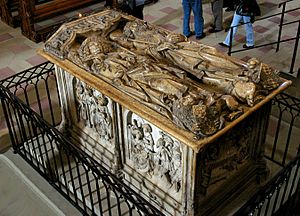
Henry II returned to Magdeburg, Germany, from southern Italy to celebrate Easter. He then became sick in Bamberg. After Easter, Henry went to his palace in Göttingen. He died there on 13 July 1024, at the age of 51. He had suffered from a painful urinary infection. Henry had been working with the Pope to hold a big Church meeting to confirm his new system of how the empire and church would work together, but he died before it was finished.
Empress Cunigunde arranged for Henry to be buried at Bamberg Cathedral. Henry left the Empire without major problems, but he also left no children to take his place. Some people think that he and Cunigunde had promised to live without having children because they were so religious. Because they had no children, the Ottonian family line ended with Henry.
In early September 1024, the German nobles met and began discussions to choose a new king. They chose a noble from Franconia named Conrad II to be Henry II's successor. Conrad was the first ruler from the Salian dynasty.
Becoming a Saint
Henry II was made a saint in July 1147 by Pope Eugene III. His wife, Cunigunde, was made a saint on 29 March 1200 by Pope Innocent III. Henry's holy remains were carried during campaigns against people who disagreed with the Church in the 1160s. He is the patron saint of the city of Basel, Switzerland.
Henry's feast day is celebrated on 13 July, the day he died. This is the traditional day for his local celebration. In 1668, it was moved to 15 July, but in 1969, it was moved back to 13 July as an optional day of remembrance.
During his life, Henry II became a special member of the Benedictine Order. Today, he is honored within the Order as the patron saint of all such members.
Family
Henry II was part of the Ottonian dynasty of kings and emperors. This family ruled the Holy Roman Empire (which was Germany before) from 919 to 1024. Henry II was the great-grandson of Henry I. He was also the great-nephew of Otto I, a cousin once removed of Otto II, and a second-cousin to Otto III.
Images for kids
-
Emperor Henry II, from the Manuscript of St. Gregory's Moralia in Job, Bamberg State Library
-
Bolesław I of Poland in a drawing by Jan Matejko
See also
 In Spanish: Enrique II del Sacro Imperio Romano Germánico para niños
In Spanish: Enrique II del Sacro Imperio Romano Germánico para niños


